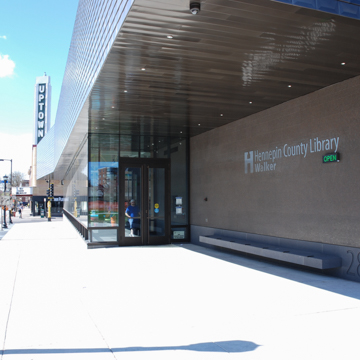Set at the crossing of Hennepin Avenue and Lagoon avenues, in the Uptown area of Minneapolis, the Walker Library is one of the first libraries to be built in twenty-first-century Minneapolis. It replaced a largely underground library facility from the 1970s. Designed by Vincent James Associates Architects, the building’s minimalist forms and materials make a neutral, contemporary addition to Uptown’s palimpsest of architectural periods and styles.
Located just across the street from the Uptown Theater (1930s, Liebenberg and Kaplan) on one of the busiest intersections in the city, the 30,000-square-foot library building is much more subtle than the Moderne theater with its soaring marquee. The Walker Library is without large signage or tall forms. Filling out the entire block corner with windows overlooking Hennepin and Lagoon avenues, the library respects the density of it surroundings. The architects took note that many of Hennepin Avenue’s old retail buildings have a masonry second- or third-story over a glassy storefront at street level. The Walker Library presents a similar kind of massing: a street-level glass curtain wall contrasts, in weight and texture, the second level “frieze” of bronze tinted panels above. This stainless steel material was originally developed as a roofing system but was adapted as a cost-effective treatment for exterior walls. As with the exposed interior trusses, this solution creates a rich pattern and visual interest using standard materials.
Because of its location on a high-volume traffic intersection, the architects moved the library’s main entry to the north end of the building, next door to the transit stations on either side of Hennepin Avenue and closer to the original, neolassical Carnegie Walker Library across the street. On the southeast side, near the Uptown Theater, the structure is set back to create a small gathering space near the busy corner and to open up a vista to the tall marquee.
The Walker Branch is designed so that all public areas—book stacks, media and computer stations, reading tables, teen and children’s spaces—are on a single level that can be easily overseen by staff. Although everything is on one floor, it is a soaring and grand one, where the clear-span structural truss system seems to accentuate the height. In the large open public area, there is ever-changing daylight and shifting tones as the hours and seasons pass. For patrons who read or work in the public areas, there is also a sense of floating above the street—rather like a terrace or front porch. On sunny days throughout the year, this open space is filled with light. The interior design strategy introduces strong furniture colors and regionally sourced walnut finishes. Even the bathrooms are bright.
Modern libraries are also meant to serve as community hubs and thus, cannot be entirely silent. But the Walker Branch’s design affords gradients of public space and quiet zones. With strategies such the noise-containing low ceiling in the children’s area and the acoustical panels on the main ceiling, noise travels very little here. Just below the acoustical ceiling, a blue transom band of sound insulating panels evokes the summer sky. Visitors can look over the low rows of shelves and out through the windows. Overhead, yellow-tinted daylight streams in from seven cubes or “light monitors,” as the architects call them. Built with yellow-tinted glass, the monitors rise from the roofline and mimic the syncopation of parapets along Hennepin Avenue.
References
Martin, Frank Edgerton. “Hennepin County Walker Library: VJAA’S New Hennepin County Walker Library takes its cues from its bustling Uptown site and surroundings.” Architecture Minnesota(November-December 2015).














